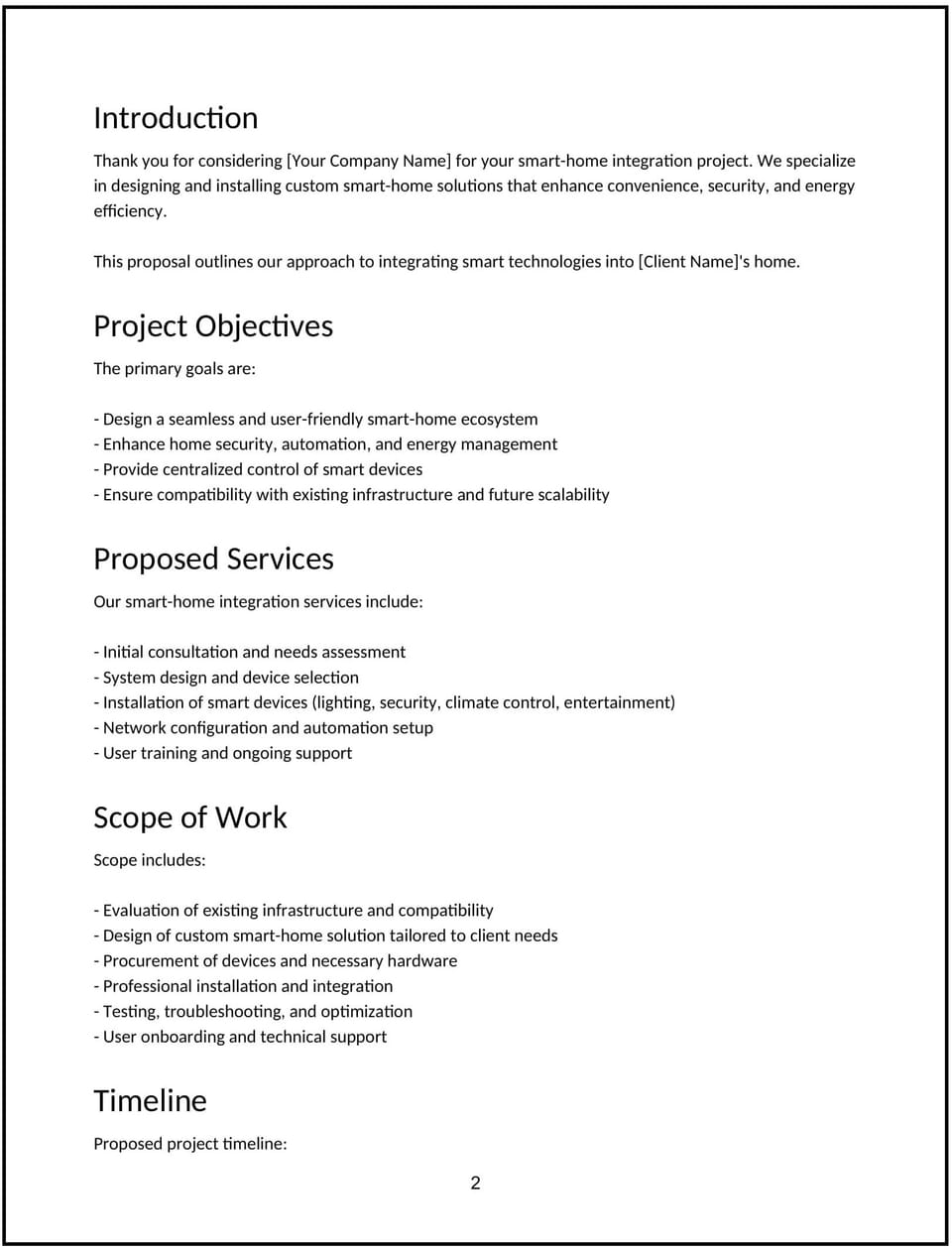Smart-home integration proposal: Free template

Customize this free smart-home integration proposal with Cobrief
Open this free smart-home integration proposal in Cobrief and start editing it instantly using AI. You can adjust the tone, structure, and content based on your offer, the property’s needs, and the client’s preferences. You can also use AI to review your draft — spot gaps, tighten language, and improve clarity before sending.
Once you're done, send, download, or save the proposal in one click — no formatting or setup required.
This template is fully customizable and built for real-world use — ideal for pitching smart-home installation and automation services to homeowners, property developers, or real estate agents. Whether you’re creating proposals daily or occasionally, this version gives you a structured head start and removes the guesswork.
What is a smart-home integration proposal?
A smart-home integration proposal outlines your plan for designing, installing, and configuring a connected system that manages devices like lighting, HVAC, security, entertainment, and appliances. It may include hardware sourcing, system setup, app configuration, voice control integration, and user training.
This type of proposal is typically used by smart-home consultants, AV technicians, or home automation companies offering turnkey solutions to residential clients.
A well-structured proposal helps you:
- Explain how your solution improves comfort, convenience, security, or energy efficiency.
- Set expectations on devices, compatibility, and support.
- Demonstrate your technical expertise and past project success.
- Build trust by clearly outlining the process, timeline, and ownership.
If you offer smart-home automation, connected device setup, or integrated home technology services, this is the right kind of proposal to use.
Why use Cobrief to edit your proposal
Instead of copying a static template, you can use Cobrief to tailor and refine your proposal directly in your browser — with AI built in to help along the way.
- Edit the proposal directly in your browser: No setup or formatting required — just click and start customizing.
- Rewrite sections with AI: Highlight any sentence and choose from actions like shorten, expand, simplify, or change tone.
- Run a one-click AI review: Get instant suggestions to improve clarity, fix vague sections, or tighten your message.
- Apply AI suggestions instantly: Review and accept individual AI suggestions, or apply all improvements across the proposal in one click.
- Share or export instantly: Send your proposal through Cobrief or download a clean PDF or DOCX version when you’re done.
Cobrief helps you create a polished, persuasive proposal — without wasting time on formatting or second-guessing your copy.
When to use this proposal
This smart-home integration proposal works well in scenarios like:
- When upgrading an existing home with modern smart systems.
- When outfitting new construction properties with connected tech.
- When working with real estate developers offering tech-forward homes.
- When responding to clients looking for convenience, energy control, or increased property value.
Use this proposal whenever you need to clearly outline your process for building and delivering a custom smart-home system.
What to include in a smart-home integration proposal
Each section of the proposal is designed to help you explain your offer clearly and professionally. Here's how to use them:
- Executive summary: Highlight how your system will improve day-to-day living, support energy savings, and future-proof the property through a cohesive, user-friendly setup.
- Scope of work: Break down what’s included — consultation, product recommendations, device sourcing, physical installation, app and voice assistant configuration, testing, and user walkthrough.
- Timeline: Provide a clear breakdown of key phases — site assessment, sourcing, installation, setup, and final testing. Include lead times for device delivery.
- Pricing: Offer a detailed quote or estimate. You can break it into labor, hardware, and support. Mention optional packages (e.g., lighting only vs. full-home automation).
- Terms and conditions: Outline warranties, device ownership, third-party platform responsibilities, and service coverage after installation.
- Next steps: Include a clear call to action — e.g., “Approve to begin device sourcing and scheduling” or “Book your site consultation to finalize system specs.”
How to write an effective smart-home integration proposal
Use these best practices to present professionalism, technical clarity, and ease-of-use:
- Make the client the focus: Emphasize comfort, convenience, security, or value — not just the tech specs.
- Personalize where it matters: Tailor device selection based on home size, user preferences, or existing systems.
- Show results, not just tasks: Reference past client outcomes (e.g., “Reduced utility bills 15%,” “Improved security response times”).
- Be clear and confident: Avoid jargon. Keep explanations client-friendly, especially when describing automation logic or platform compatibility.
- Keep it skimmable: Use clear formatting, bullets, and short paragraphs — especially if the client is not technically inclined.
- End with momentum: Finish with a confident CTA that gets the project moving.
Frequently asked questions (FAQs)
What’s the best way to explain device compatibility?
Use brand names (e.g., Nest, Philips Hue, Ring) and mention ecosystems (e.g., Apple HomeKit, Google Assistant, Alexa) to help the client visualize the setup.
Should I include options for both basic and advanced systems?
Yes — offering tiers (e.g., Starter, Premium, Full-Home) makes it easier for clients to choose based on budget and interest.
Can I reuse this proposal for both homeowners and developers?
Absolutely — just update the language. Developers may care more about resale value and bulk installs, while homeowners may focus on convenience or energy savings.
How do I handle third-party warranties and platforms?
Clarify what you support directly vs. what the manufacturer covers. Set expectations early around support boundaries for apps or connected devices.
Should I offer ongoing maintenance or tech support?
If you do, mention it as an optional add-on — like a monthly retainer, yearly inspection, or priority support package. Many clients appreciate ongoing help after install.
This article contains general legal information and does not contain legal advice. Cobrief is not a law firm or a substitute for an attorney or law firm. The law is complex and changes often. For legal advice, please ask a lawyer.